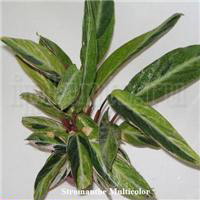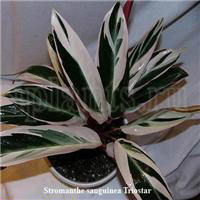Marant family. Homeland is the tropics of America. There are 15 species in nature. Stromanta is often confused with calathea and even with ktenanta. In fact, some botanists do not even separate the stromanta into a separate genus and do not share it with the Calatheans .
Blood-red Stromanthe sanguinea is common in culture - it is a tall plant, up to 1 m tall, leaves about 20-30 cm long, narrow-oval or lanceolate. Its varieties differ somewhat in leaf color. Some have broad light stripes and spots on the upperside, while others have only a light stripe along the central vein, but all have leaf underside and petioles purplish-red.
- Stromanthe sanguinea 'Multicolor' Stromanta blood-red multicolor is distinguished by a wide range of shades on the leaves - from white, light green to dark green, the reverse side of the leaves is bard. Characteristic of this variety is the distribution of spots in the form of small splashes on the sheet.
- Stromanthe sanguinea 'Maroon' - has a pure green leaf plate with a pronounced lighter central vein, the reverse side of the leaf is bard. It occurs as a houseplant rarely in view of less decorativeness.
- Stromanthe sanguinea 'Triostar' - the most common variety, has characteristic alternating spots-stripes of green, white-pink, the reverse side of the leaf is bard.
Grooming Stromanta
Temperature: Stromanta is thermophilic. In summer, for good growth, the optimal temperature is 20-30 ° C, in winter 18-20 ° C. The minimum for it at any time of the year is 12 ° С (with dry soil it is possible up to + 10 ° С), it does not tolerate a directed draft. In winter, plants should not be placed close to window panes, and cold air from unglued frames should be feared.
Lighting: Bright scattered light or light partial shade, in bright light and in too dark a place the color of the leaves is lost. Stromanta refers to shade-tolerant, but not shade-loving plants. Most species of stromante with painted tricolor leaves need more intense lighting.
Watering: Abundant when the temperature is above 22-24 ° C, moderate if cooler than 20 ° C. You only need to water with soft and warm water. Stromanta does not tolerate chlorine and fluoride in water. If your stromanta dries the ends of the leaves, and the humidity is high enough, ask if the fluoride content in tap water is increased in your area. Try watering with butylated water. Stromanta does not like strong overdrinking and systematic waterlogging.
Fertilizer: From May to August, the stromante is fed with liquid complex fertilizer for indoor ornamental and deciduous plants every two weeks, the fertilizer is taken in half a dose. The plant is sensitive to excess or overfeeding with fertilizers.
Air humidity: Stromanta, like all marants, loves very humid air - not lower than 55%, but with humidity above 80% you need to ventilate the room more often. Regular leaf sprays are needed to increase air humidity. In the heating season in winter, the pot is placed on a tray with wet pebbles or covered with sphagnum moss, which is often sprayed.
Transplantation: Annually in February - March into loose, light soil, consisting of 2-3 parts of leaf, 1 part of peat, 1 part of humus, 1 part of coniferous land with an admixture of sand. Pieces of charcoal are added to the soil mixture. Stromanta does not tolerate lime content in soil. You can use a purchased soil mixture for azaleas. The capacity for these plants should not be deep. Good drainage is mandatory.
Reproduction: Division when transplanted in spring. The pots are covered with a plastic bag and kept warm until the plants take root.



